Canada Agrochemicals Market Size
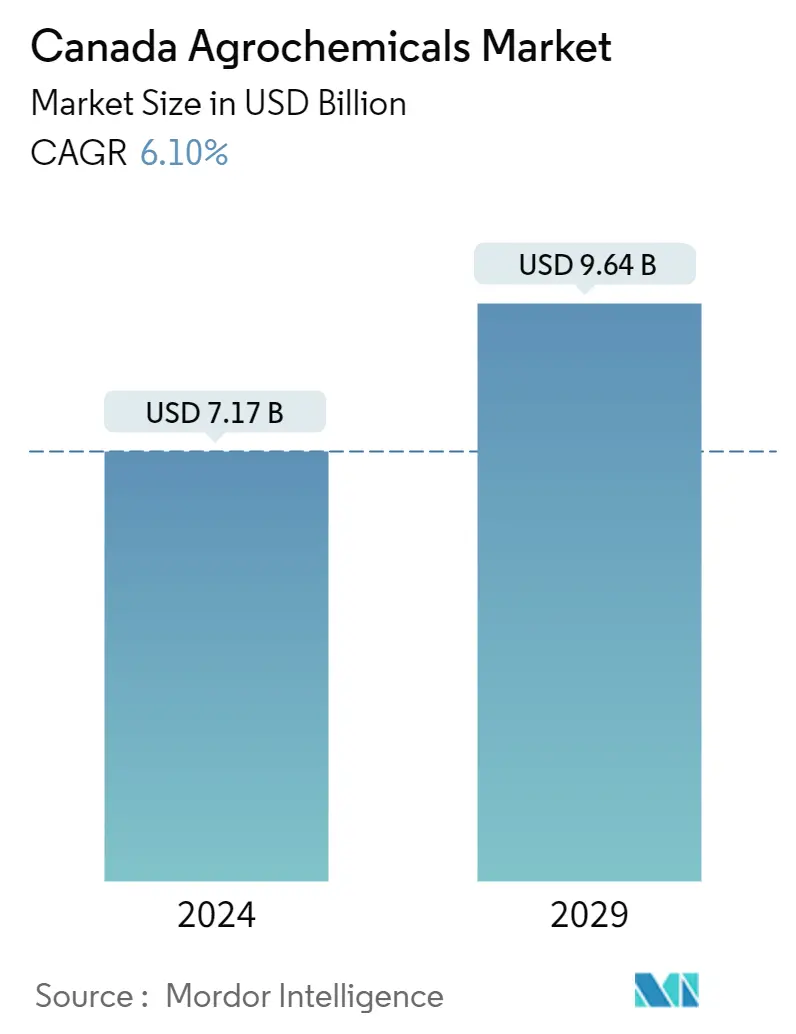
| Study Period | 2019 - 2029 |
| Base Year For Estimation | 2023 |
| Market Size (2024) | USD 7.17 Billion |
| Market Size (2029) | USD 9.64 Billion |
| CAGR (2024 - 2029) | 6.10 % |
| Market Concentration | High |
Major Players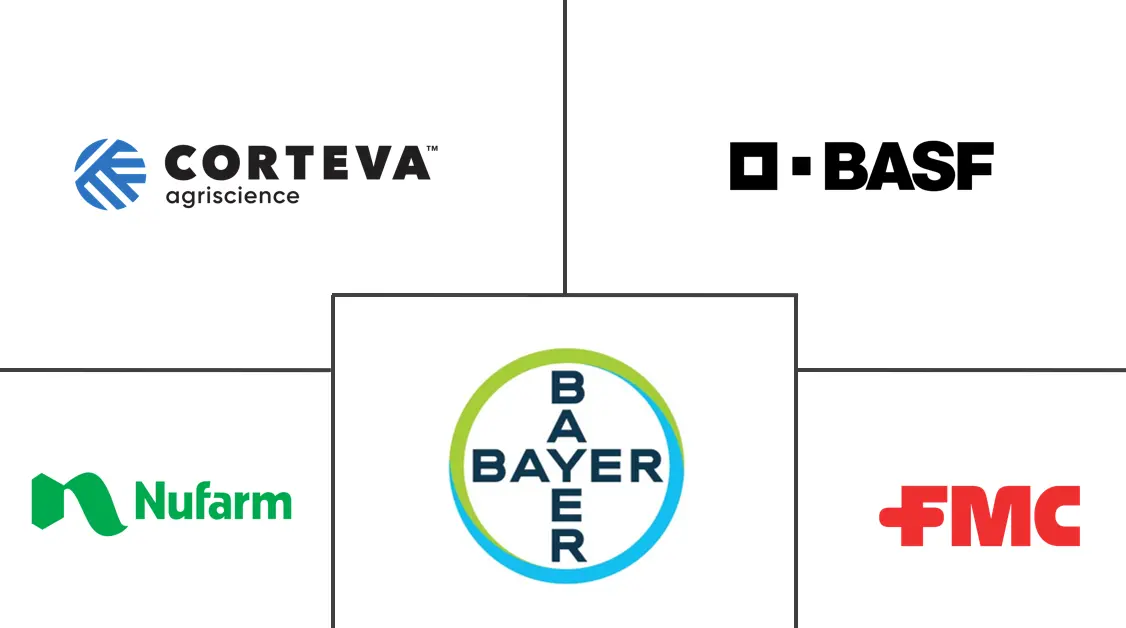
*Disclaimer: Major Players sorted in no particular order |
Canada Agrochemicals Market Analysis
The Canada Agrochemicals Market size is estimated at USD 7.17 billion in 2024, and is expected to reach USD 9.64 billion by 2029, growing at a CAGR of 6.10% during the forecast period (2024-2029).
- The agrochemical market in Canada is an important agriculture support industry that boosts agriculture output in the country. Since strict restrictions are a major factor in determining the market's direction, there is an increasing need to strike a balance between the prudent use of the best chemicals and reducing the impact of those uses. Innovative and eco-friendly products and solutions are emerging steadily in the country, which is anticipated to drive the market.
- Demand for healthy diets has increased the consumption of cereals, fruits, and vegetables in Canada. This has resulted in integration among growers, federal governments, and industries to improve crop yield to meet Canada's food supply requirements. While all this is done, proper care is applied to not cause any adverse effects on human safety and ecological balance. Canada is expected to exceed the United States by registering faster growth in terms of value demand because of the country's exclusive focus on revamping its agriculture sector.
- The herbicides segment in the country is growing rapidly due to the increasing incidence of weeds in major crops such as Wheat, Canola, Soybean, and Maize. Coupled with major players in the market offering numerous herbicides, the herbicide segment in Canada holds a more prominent place in the agrochemicals market.
Canada Agrochemicals Market Trends
Need for Improving Productivity by Limiting the Crop Damage
- The demand for pest management products is being driven by the emergence of new pests and diseases, leading to crop loss. Customers are increasingly looking for targeted and effective solutions to improve their yield. Thus, crop protection is a key strategy farmers adopt to limit crop damage and enhance productivity.
- According to the Food and Agriculture Organization (FAO), in 2018, soybeans production was 7.41 million metric tons, which gradually decreased to 6.22 million metric tons in 2021, mainly due to the infestation from two prominent pests, namely soybean aphids and two-spotted spider mites (TSSM). The pest incidence was mitigated through the wide application of pesticides, which helped in retrieving the crops.
- Market players are putting constant efforts into introducing advanced agrochemicals to enhance domestic crop production. For instance, in 2019, BASF launched a critical insecticide, Sefina, for use in Canadian soybeans and potatoes.
- There are rampant instances of crop damage due to disease incidence, causing enormous losses to economically important crops. This has created the need for new fungicide development and compelled farmers to adopt an intensified application of agrochemicals such as fungicides and insecticides, which is anticipated to increase the market during the forecast period.
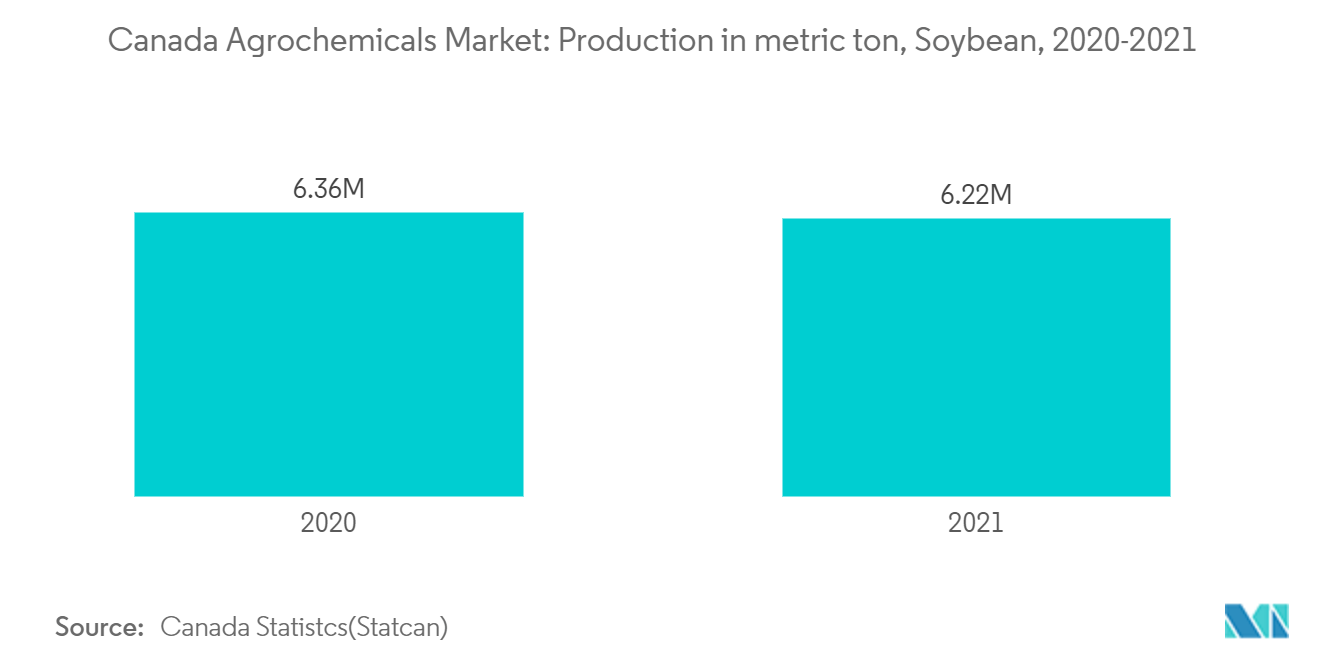
Rising Adoption of Bio-based Agrochemicals
- Owing to the escalating demand for food safety and quality, biopesticides are gaining popularity over their synthetic counterparts. Although the prevalence of synthetic or chemical pesticides continues, an emerging preference for biological pesticides has been observed in recent years in the country primarily due to the rapid adoption of sustainable agricultural practices, such as integrated pest management (IPM) techniques and organic farming.
- According to Official Canada Government Statistics, in 2021, the organic cultivation area of fruits was 35,289 acres, and for vegetables, it was 12,268 acres which have been increasing steadily for a decade. Furthermore, growing consumer concern over food safety is driving the use of organic products, which leads to the use of biopesticides rather than chemicals. Canada's total organic food market was USD 4.4 billion in 2018, which rose to 4.9 billion in 2021.
- Because of industrious organic food producers and the organizations that assist them, the organic industry is one of Canada's fastest-growing sectors. Cooperation and partnership are critical to ensuring this industry grows to satisfy rising customer demand. The ongoing investments and activity in the organic market will likely benefit the bio-based agrochemical market.
- In March 2022, the Minister of Agriculture and Agri-Food (MAAF) invested USD 103,400 in the Organic Federation of Canada (OFC) to facilitate a new cooperation that will support the sustainability and expansion of Canada's organics business.
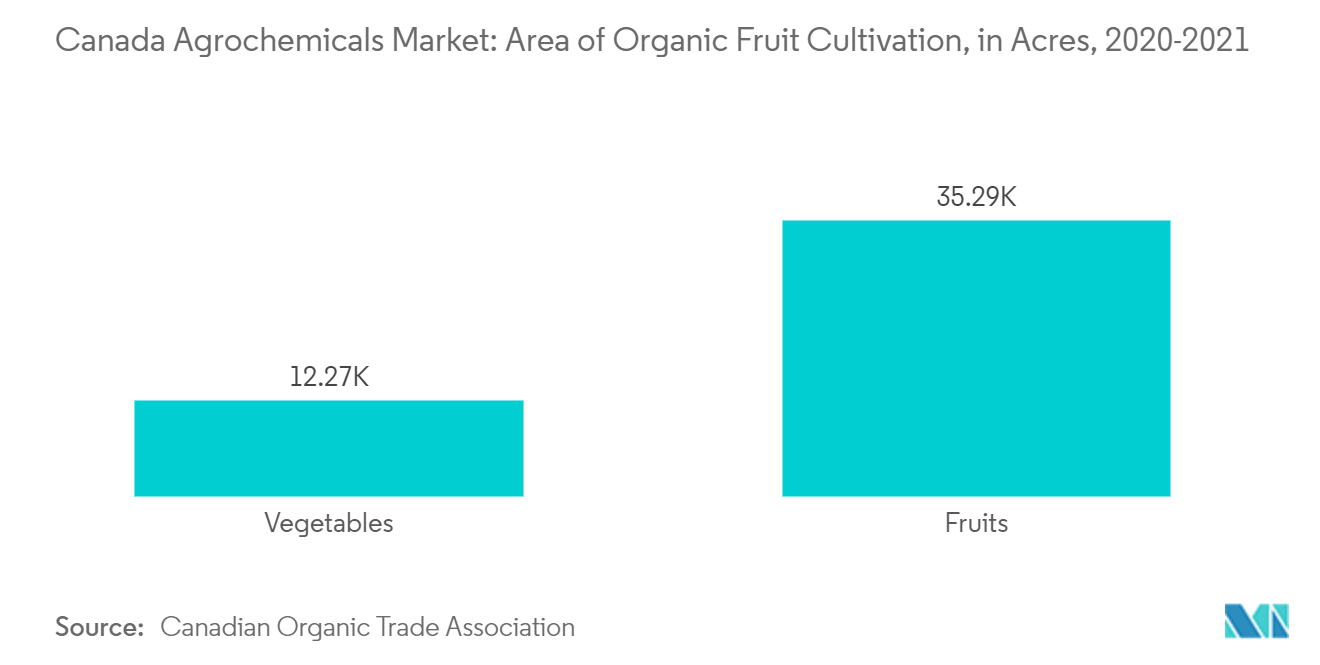
Canada Agrochemicals Industry Overview
Canada's agrochemicals market is highly consolidated with the major players, including Bayer CropScience AG, Corteva Agriscience, BASF SE, FMC Corporation, and Nufarm Ltd. Given the large operational area and never-ending need of the agrochemical industry, many market players and companies have entered the industry. The major players in the market are competing to hold a consistent market share. Mergers and acquisitions, partnerships, expansions, and product launches are some of the major business strategies adopted by the aforementioned major players.
Canada Agrochemicals Market Leaders
-
Bayer CropScience AG
-
Corteva Agriscience
-
BASF SE
-
FMC Corporation
-
Nufarm Ltd
*Disclaimer: Major Players sorted in no particular order
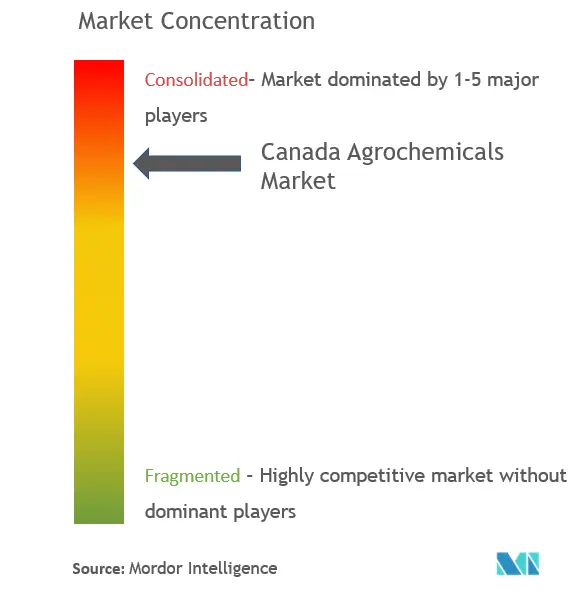
Canada Agrochemicals Market News
- September 2022: Gowan Canada and ISK BioSciences launched 'Insight 339SC', a new group 14 herbicide for pre-seed burnoff applications in wheat, corn, and soybean. Insight 339SC provides rapid and effective pre-seed burndown of important broadleaf weeds like kochia, redroot pigweed, common lamb's quarters, and wild buckwheat.
- July 2022: Pivot Bio, agriculture's leading nitrogen innovator, announced its expansion into Canada, including launching the company's business operations, appointing its leadership team, and its future plans to offer sustainable nitrogen to Canadian farmers, pending regulatory approvals.
- May 2022: Protein Industries Canada announced a USD 19 million project along with a consortium of companies that will help Canadian farmers further improve their substantiality and reduce carbon emissions through the commercialization of a new micronutrient fertilizer.
Canada Agrochemicals Market Report - Table of Contents
1. Introduction
- 1.1 Study Assumptions and Market Definition
- 1.2 Scope of the Study
2. Research Methodology
3. Executive Summary
4. Market Dynamics
- 4.1 Market Overview
- 4.2 Market Drivers
- 4.3 Market Restraints
-
4.4 Porter's Five Forces Analysis
- 4.4.1 Bargaining Power of Suppliers
- 4.4.2 Bargaining Power of Buyers
- 4.4.3 Threat of Substitute Products
- 4.4.4 Threat of New Entrants
- 4.4.5 Intensity of Competitive Rivalry
5. Market Segmentation
-
5.1 Type
- 5.1.1 Fertlizers
- 5.1.2 Pesticides
- 5.1.3 Adjuvants
- 5.1.4 Plant Growth Regulators
-
5.2 Application
- 5.2.1 Grains and Cereals
- 5.2.2 Pulses and Oilseeds
- 5.2.3 Fruits and Vegetables
- 5.2.4 Turf and Ornamental Grass
6. Competitive Landscape
- 6.1 Most Adopted Strategies
- 6.2 Market Share Analysis
-
6.3 Company Profiles
- 6.3.1 Syngenta
- 6.3.2 Bayer CropScience AG
- 6.3.3 FMC Corporation
- 6.3.4 BASF SE
- 6.3.5 Nufarm Ltd
- 6.3.6 Corteva Agriscience
- 6.3.7 Adama Agricultural Solutions Ltd
- 6.3.8 Archer-daniels-midland (ADM)
- 6.3.9 UPL Limited
- 6.3.10 Dow Agrosciences LLC
- *List Not Exhaustive
7. Market Opportunities and Future Trends
** Subject To AvailablityCanada Agrochemicals Industry Segmentation
An agrochemical is a chemical product used in agriculture to enhance crop health and boost yield.
The Canada agrochemicals market is segmented by product type (fertilizer, pesticides, adjuvants, and plant growth regulators) and application (grains and cereals, pulses and oilseeds, fruits and vegetables, and turfs and ornamental grass).
The report offers market sizing in USD million in terms of value.
| Type | Fertlizers |
| Pesticides | |
| Adjuvants | |
| Plant Growth Regulators | |
| Application | Grains and Cereals |
| Pulses and Oilseeds | |
| Fruits and Vegetables | |
| Turf and Ornamental Grass |
Canada Agrochemicals Market Research FAQs
How big is the Canada Agrochemicals Market?
The Canada Agrochemicals Market size is expected to reach USD 7.17 billion in 2024 and grow at a CAGR of 6.10% to reach USD 9.64 billion by 2029.
What is the current Canada Agrochemicals Market size?
In 2024, the Canada Agrochemicals Market size is expected to reach USD 7.17 billion.
Who are the key players in Canada Agrochemicals Market?
Bayer CropScience AG, Corteva Agriscience, BASF SE, FMC Corporation and Nufarm Ltd are the major companies operating in the Canada Agrochemicals Market.
What years does this Canada Agrochemicals Market cover, and what was the market size in 2023?
In 2023, the Canada Agrochemicals Market size was estimated at USD 6.76 billion. The report covers the Canada Agrochemicals Market historical market size for years: 2019, 2020, 2021, 2022 and 2023. The report also forecasts the Canada Agrochemicals Market size for years: 2024, 2025, 2026, 2027, 2028 and 2029.
Canada Agrochemicals Industry Report
The Canada Agrochemicals market is a crucial segment within the agricultural sector, encompassing various product types such as fertilizers, pesticides, adjuvants, and plant growth regulators. This market analysis provides a comprehensive industry overview, highlighting the market size, market share, and market growth. The industry report includes detailed industry statistics and a market forecast, offering insights into the market outlook and market trends.
The report covers the application of agrochemicals across different segments, including grains and cereals, pulses and oilseeds, fruits and vegetables, and turfs and ornamental grass. The market segmentation helps in understanding the specific needs and market value within each segment. The industry research delves into the growth rate and industry size, providing an in-depth industry analysis and market review.
This market report is an essential resource for understanding the market data and market predictions. It includes industry information and industry trends, which are crucial for market leaders and research companies. The industry outlook and market forecast provide a future perspective on the industry sales and market growth.
For a more detailed understanding, the report example and report PDF are available for download. These industry reports offer valuable insights, including industry research and industry statistics, to help stakeholders make informed decisions. The market overview and market outlook sections of the report provide a clear picture of the current market scenario and future prospects.
In conclusion, this report is a comprehensive guide for anyone interested in the Canada Agrochemicals market, offering a thorough market analysis and industry research. The report includes all necessary information, from market segmentation to market value, ensuring a complete understanding of the industry.



